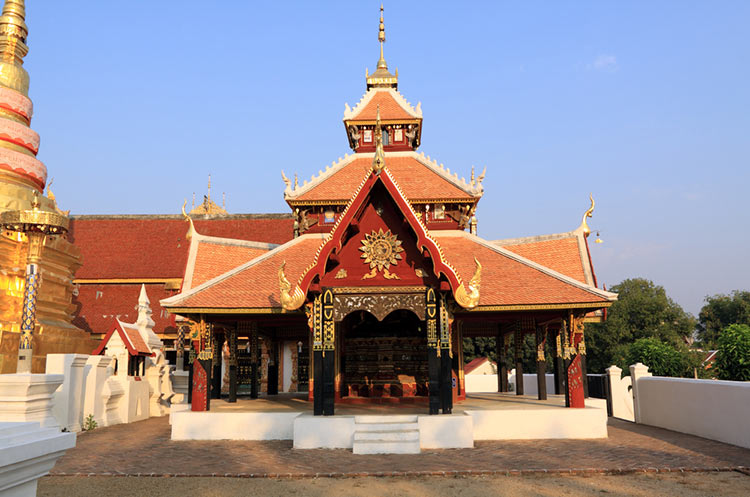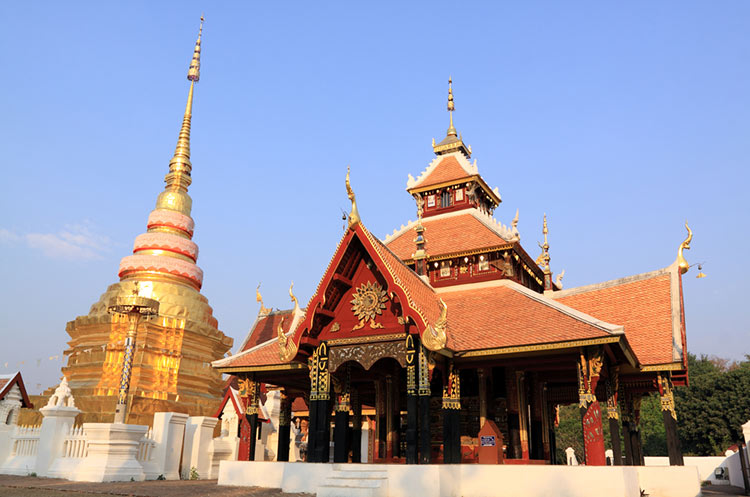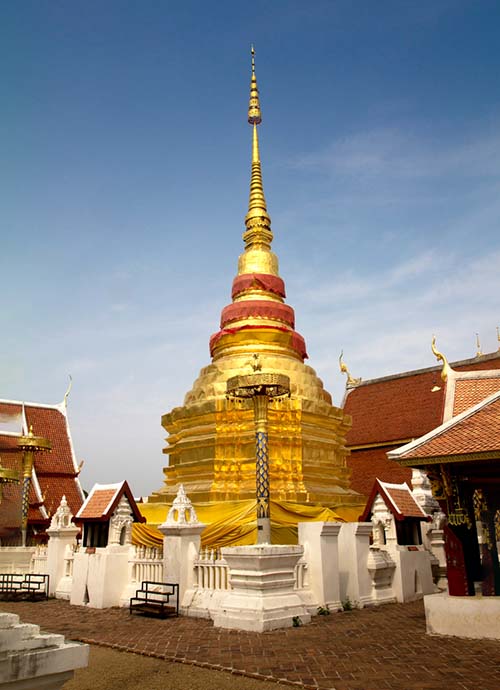
Wat Pongsanuk
Burmese temple with a unique cruciform viharn
Lampang
On the banks of the Wang river in the town of Lampang is the Wat Pongsanuk, a beautiful temple built in a mix of Lanna and Burmese Shan styles. The temple that is also called Wat Pongsanuk Tai was built in 1886 by wealthy Burmese immigrants employed in the teak logging industry.
Between the end of the 19th century and the early 20th century Lampang was a center of teak logging in North Thailand. During those years many Burmese came to the Lampang area, who built a number of Burmese style monasteries as an act of gaining merit.
Naga staircase
The Southern part of the temple complex is built on top a small mound. A Naga staircase leads up to the large stuccoed arched entrance gate. Inside the walled area are a chedi and two viharns.
The Wat Pongsanuk’s most interesting building is an open, teak wood Burmese style viharn. The unique building named Viharn Phra Chao Phan Ong was carefully restored during a four year restoration project.
Viharn Phra Chao Phan Ong
The first viharn is a 19th century teak wood building, a unique structure that is a mix of Lanna and Burmese styles. The viharn named Viharn Phra Chao Phan Ong is open on all sides and has a cruciform floor plan; four large porches of equal length are protruding out of the structure.
Burmese style roof with a hti
Its tiled roof is a three tiered Burmese design, the ends decorated with golden stylized Naga serpents. It is topped with a hti, a multi tiered ornamental umbrella often found on top of Burmese temples. The roof is supported by very intricately decorated pillars.
Interior
The viharn’s interior is decorated with Lanna style floral motifs carved in teak wood. Also found in the interior are depictions of Hamsa, the mount of the Hindu God Brahma and depictions of several mythological creatures such as Kinnaree, a creature half human, half bird.
Votive tablets
The viharn’s upper walls are lined with hundreds of votive Buddha tablets, of which there were originally over a thousand. Many have disappeared during World War II when Lampang was occupied by the Japanese army.
Buddha images sitting back to back
At the center of the viharn, set on a high pedestal are four seated Buddha images sitting back to back, facing all four directions. The images that were cast in the 16th century sit with their back to a metal Bodhi tree, the tree that sheltered the Buddha while meditating.

UNESCO award for conservation
When at the start of the 21th century the unique structure was in a bad state of repair, it was decided to restore the viharn instead of demolishing it and rebuilding new. A project started in 2004 to preserve this important and unique Thai historic structure, following its original design and using the original materials as much as possible.
In 2008, the Wat Pongsanuk restoration project received the Award of Merit, a UNESCO award for cultural heritage conservation.
The chedi and other structures
Behind the Viharn Phra Chao Phan Ong is the second viharn on the mound. This viharn houses a large Reclining Buddha image, which symbolizes the passing of the Buddha into final Nirvana.
The Wat Pongsanuk’s chedi is completely covered with copper, glistering in the sun. The spiral Lanna style chedi is set on a square base, on top is an ornamental multi tiered umbrella.
Small museum
A small museum exhibits hundreds of Buddha images, including seated, walking and reclining Buddhas in several mudras (hand gestures). Some of them are hundreds of years old. Also on display are ancient hand written scrolls that were found during the restoration works.

How to get to the Wat Pongsanuk
The temple is located in the Muang district in central Lampang town. It is found on Pongsanuk road, just North of the Wang river.
The easiest way to get there is by songthaew or by horse drawn carriage.
Opening hours
The temple opens daily during daylight hours, from around 6 am until 6 pm.
Entrance fee
Admission is free.
- Wat Phra That Lampang Luang
- Wat Sri Chum
- Wat Si Rong Muang
- Wat Phra Kaew Don Tao
- Wat Pongsanuk Tai
- Wat Suchadaram